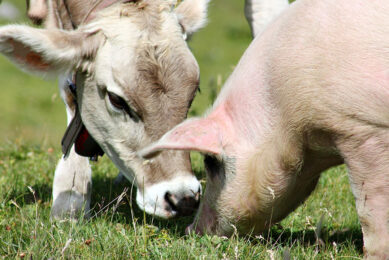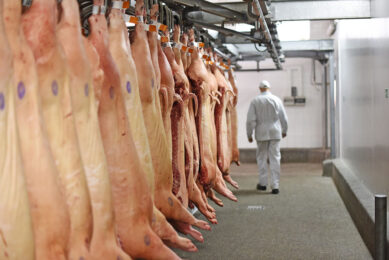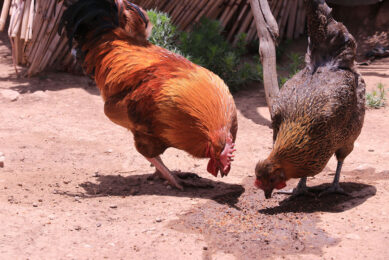Animal feed: the weakest link in the food chain?

Since the 1990s, the European agri-food industry has been marked by a series of scandals the majority of which, for example, Mad Cow Disease, Dioxin and MPA, can be directly linked to animal feed contamination. We must therefore ask ourselves, is animal feed indeed the weakest link in the food chain?
By David Byrne
As concerns continue to mount globally, the time has come for all
stakeholders to address this issue which jeopardises the reputation of the feed
industry and has serious implications for international food trade.
stakeholders to address this issue which jeopardises the reputation of the feed
industry and has serious implications for international food trade.
Within the European Union, the White Paper on Food Safety (12 January
2000), investigating areas such as traceability, labelling, hygiene and risk
assessment, has paved the way for extensive legislative reform. As well as a
comprehensive risk analysis and risk management strategy, a ‘three pillar’
approach was adopted comprising of a full range of Food and Safety Laws; the
setting up of a new independent European Food Safety Authority, and the
introduction of an effective control and enforcement mechanism.
2000), investigating areas such as traceability, labelling, hygiene and risk
assessment, has paved the way for extensive legislative reform. As well as a
comprehensive risk analysis and risk management strategy, a ‘three pillar’
approach was adopted comprising of a full range of Food and Safety Laws; the
setting up of a new independent European Food Safety Authority, and the
introduction of an effective control and enforcement mechanism.
An additional important aspect is the industry voluntary initiative and
complementarities with regulatory ones, which are also part of the EU response
on food safety issues.
complementarities with regulatory ones, which are also part of the EU response
on food safety issues.
A new challenge
Although the introduction of
legislation targeting different elements of the food chain has led to enhanced
consumer confidence, globalisation continues to pose a challenge. Implementation
is also a key one. A situation where different rules apply in different
countries, for example permitted levels of residues or contaminants, provokes
problems. Is there now a new challenge to move towards a system of global risk
assessment that is accepted by all? How far can this build on the EU laws and
relating industry initiatives?
Although the introduction of
legislation targeting different elements of the food chain has led to enhanced
consumer confidence, globalisation continues to pose a challenge. Implementation
is also a key one. A situation where different rules apply in different
countries, for example permitted levels of residues or contaminants, provokes
problems. Is there now a new challenge to move towards a system of global risk
assessment that is accepted by all? How far can this build on the EU laws and
relating industry initiatives?
Developing countries are heavily dependent on food exports and experience
has shown that this is where most problems arise. As the world’s largest
importer of food (who together with the US account for 70% of import demand),
the EU has a huge responsibility to ensure that national standards conform to
international rules and that all stakeholders are at least in compliance with
guidelines set by international standard setting bodies, such as the Codex
Alimentarius Commission. As well as protecting the health of consumers and
ensuring fair trade practices in food trade, compliance with international
standards will ultimately help mitigate WTO disputes. To this end, much progress
has been made and as the EU has extended its reach to trade food products all
over the world, so too have EU food standards been exported worldwide. We have
already seen greater co-operation between EFSA and the FDA, as well as the
authorities in China. Countries approved for trading with the EU must comply
with the requirement that they are able to inform Brussels of serious food
safety concerns within 24 hours of an outbreak. The US is now requiring
comparable measures to be in place with their trading partners. Consequently, a
producer providing total traceability has a big competitive advantage.
has shown that this is where most problems arise. As the world’s largest
importer of food (who together with the US account for 70% of import demand),
the EU has a huge responsibility to ensure that national standards conform to
international rules and that all stakeholders are at least in compliance with
guidelines set by international standard setting bodies, such as the Codex
Alimentarius Commission. As well as protecting the health of consumers and
ensuring fair trade practices in food trade, compliance with international
standards will ultimately help mitigate WTO disputes. To this end, much progress
has been made and as the EU has extended its reach to trade food products all
over the world, so too have EU food standards been exported worldwide. We have
already seen greater co-operation between EFSA and the FDA, as well as the
authorities in China. Countries approved for trading with the EU must comply
with the requirement that they are able to inform Brussels of serious food
safety concerns within 24 hours of an outbreak. The US is now requiring
comparable measures to be in place with their trading partners. Consequently, a
producer providing total traceability has a big competitive advantage.
Benefits for industry
The feed company that can reach global
standards will accrue a range of benefits including, certainty, trouble free
access to markets, and a high
The feed company that can reach global
standards will accrue a range of benefits including, certainty, trouble free
access to markets, and a high
reputation for its products. Tomorrow’s
successful suppliers see global standards (whether Government or private
standards) not as a burden or a crisis, but as a means to sustainably enhance
reputation. Amongst the success stories is FAMI-QS which has quickly established
itself as the global reference for the feed additives.
(Picture right: David Byrne is the former European Commissioner for
health and consume protection and current non-executive director of
Alltech.)
health and consume protection and current non-executive director of
Alltech.)
There is an opportunity for the industry to get involved in lawmaking by
making the results of innovation policy available to policy makers in the EU.
The application of resources to such an objective produces valuable outcomes for
all. Better regulation will lead to enhanced stakeholder consultation, reduced
bureaucracy, high quality impact assessments and will ultimately provide more
room for voluntary agreements with the industry.
making the results of innovation policy available to policy makers in the EU.
The application of resources to such an objective produces valuable outcomes for
all. Better regulation will lead to enhanced stakeholder consultation, reduced
bureaucracy, high quality impact assessments and will ultimately provide more
room for voluntary agreements with the industry.
This article is taken from a presentation given at Fefana’s (Eu Feed
Additive & Premixture Association) Annual General Meeting on Thursday 15
June in Brussels.
Additive & Premixture Association) Annual General Meeting on Thursday 15
June in Brussels.
Source: Feed Tech magazine. Volume 12. No.
7
7
Join 26,000+ subscribers
Subscribe to our newsletter to stay updated about all the need-to-know content in the feed sector, three times a week. Beheer
Beheer









 WP Admin
WP Admin  Bewerk bericht
Bewerk bericht